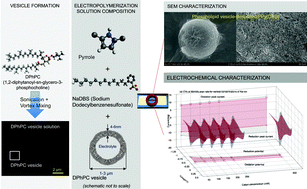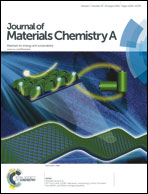Phospholipid vesicles as soft templates for electropolymerization of nanostructured polypyrrole membranes with long range order†
Abstract
Unilamellar vesicles are for the first time used as soft-templates in the electropolymerization of polypyrrole membranes with nanoscale organization and mesoscale order. The dimensions of vesicles (∼100–1000 nm) used as templates and the electropolymerization conditions lead to the formation of highly organized polypyrrole shells (10–25 nm thick) that are contiguous through the bulk of the membrane. These membranes templated with phospholipid vesicles are referred to as ‘biotemplated’ membranes and the technique ‘biotemplating’ owing to phospholipid's role as the fundamental building block of all cell membranes. Biotemplated polypyrrole membranes demonstrate higher specific surface area and subsequently higher specific capacitance than planar polypyrrole membranes and other nanostructured polypyrrole membranes for sodium and lithium ion storage. The higher specific capacitance resulting from biotemplating is explained through a mechanistic interpretation of the redox process using the number of accessible redox sites at the polymer–electrolyte interface. A direct correlation between the accessible and total number of redox sites in the polymer and specific capacitance of the conducting polymer is developed to illustrate the 45% increase in specific capacitance of biotemplated polypyrrole membranes.


 Please wait while we load your content...
Please wait while we load your content...